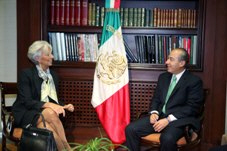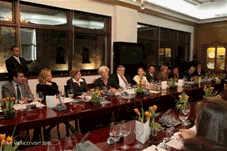
Typical street scene in Santa Ana, El Salvador. (Photo: iStock)
IMF Survey: Spotlight on G-20 as Mexico Takes Over Leadership
November 30, 2011
- IMF chief visits Peru, Mexico, and Brazil
- Turmoil in Europe could affect Latin America
- Priority is to sustain growth in volatile environment
With Mexico taking over leadership of the Group of Twenty (G-20) industrial and emerging market countries at a critical time, IMF Managing Director Christine Lagarde is visiting Latin America this week and discussed dangers for the global economy and some bright spots.

Christine Lagarde with Mexican President Felipe Calderon. Mexico takes over as Chair of the G-20 on December 1 (photo: Ariel Gutierrez)
Lagarde Visits Latin America
Mexico takes over as Chair of the G-20 on December 1 and will assume a major role in forming the policy agenda for the G-20 in the next 12 months.
In a statement at the end of her visit to Mexico, Lagarde said that she discussed Mexico’s ambitious G-20 agenda with President Felipe Calderón, including “putting a stop to the debt crisis in Europe, achieving medium-term fiscal consolidation in advanced economies, global rebalancing, and supporting reforms that strengthen the role of the IMF.”
The IMF chief is on a five-day trip to Peru, Mexico, and Brazil to meet with government officials and business leaders to discuss the challenges facing the global economy and its implications for the region.
Latin America not immune
In a blog ahead of her visit to the region, Lagarde said that Latin America is doing relatively well and enjoying strong economic management. In fact, the “new Latin America can provide some lessons to the advanced countries—such as saving for a rainy day, and making sure risks in the banking system are under control,” she added.
But the IMF chief warned that Latin America is not immune to the global environment, including the turmoil in Europe. “In our interconnected world, there is simply nowhere to hide. And so countries in the region should take all necessary precautions to make all needed preparations,” she said.
Mexico’s rapid recovery
Lagarde also discussed Mexico’s economic developments with the authorities. She noted that Mexico has rebounded strongly from the global crisis, thanks to the country’s strong fundamentals and skillful policy management.
In addition, three successive Flexible Credit Line (FCL) arrangements—an insurance option created in 2009 for the IMF’s strongest performing members—have supported Mexico’s economic policies by providing a significant buffer against potential global risks.
Last week, the IMF’s Executive Board enhanced its lending toolkit to provide liquidity and emergency assistance more effectively to its members, including those affected during periods of heightened economic or market stress—the crisis-bystanders.

In Mexico, Christine Lagarde also met with leading female executives (photo: José Mata)
Fallout from European debt crisis
“The storm in the euro area casts a long shadow over the entire global economy,” said Lagarde in her blog.
She therefore called on Latin American countries to continue rebuilding buffers—including by maintaining prudent fiscal policies—to create room for maneuver should the economic situation turn sour.
Going forward, the key challenge for Latin America, Lagarde said, is to sustain growth in a very volatile environment.
“But growth alone is just the first step. The region in general needs more socially inclusive growth, which means efforts to build fairer societies based on shared opportunities and social justice,” she added.
Latin America’s new rising star
Earlier in the week, in a statement at the end of her visit to Peru, Lagarde said that the country is one of the “most vibrant economies in the world.”
Peru’s decade-long expansion—the longest on record—has resulted in a tripling of per capita income and a 20-point fall in poverty rates. “Peru certainly has a lot to be proud of,” she said.
Lagarde and the Peruvian authorities agreed that the country can cement the gains over the past decade by moving toward more inclusive growth. “There are still some big challenges on the social agenda—widespread rural poverty, chronic malnutrition among indigenous children, and lack of access to social services (especially in rural areas). These challenges can be effectively tackled with the joint efforts of the government, private sector, and society in general,” Lagarde said.
In Peru, Lagarde also discussed topics like job creation, sustainability, and social inclusion with small and medium entrepreneurs.
The IMF chief continues her visit to Brazil with a meeting in Brasilia with President Dilma Rousseff and with Finance Minister Guido Mantega. On Friday, Lagarde will participate in a televised event in São Paulo at Globo TV—Brazil’s largest network.
Earlier in the month, after attending the G-20 summit in France, Lagarde visited several major cities in Asia. Her four-day trip to Asia was followed by a visit to Honolulu, Hawaii to attend the summit of leaders of the Asia-Pacific Economic region.







